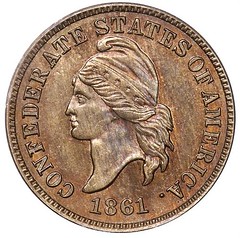
About UsThe Numismatic Bibliomania Society is a non-profit organization promoting numismatic literature. For more information please see our web site at coinbooks.org SubscriptionsThose wishing to become new E-Sylum subscribers (or wishing to Unsubscribe) can go to the following web page link MembershipThere is a membership application available on the web site Membership Application To join, print the application and return it with your check to the address printed on the application. Membership is only $15 to addresses in the U.S., $20 for First Class mail, and $25 elsewhere. For those without web access, write to: David M. Sundman, Secretary/TreasurerNumismatic Bibliomania
Society AsylumFor Asylum mailing address changes and other membership questions, contact David at this email address: dsundman@LittletonCoin.com SubmissionsTo submit items for publication in The E-Sylum, just Reply to this message, or write to the Editor at this address: whomren@coinlibrary.com
BUY THE BOOK BEFORE THE COINYou won't regret it! |
- WAYNE'S WORDS: THE E-SYLUM JULY 10, 2011
- LAKE BOOKS SALE #108 CLOSES JULY 12, 2011
- NEW BOOK: A REGISTER OF LIBERTY SEATED HALF DOLLARS, VOLUME III, NEW ORLEANS
- KARL MOULTON TO SPEAK ON JOHN J. FORD, JR. AND THE ‘FRANKLIN HOARD'
- JAMES E. CHARLTON AT 100
- M. H. BOLENDER'S COIN CHATTER
- MORE ON THE CONSTELLATION SOUVENIR MEDAL
- A CONFUSION OF SIMILAR CONSTELLATION MEDALS
- MORE ON THE LOVETT CONFEDERATE CENT
- NOTES FROM E-SYLUM READERS: JULY 10, 2011
- QUERY: U.S. MINT CAPT. BIDDLE MEDAL
- ARTICLES COVER 1933 DOUBLE EAGLE LEGAL BATTLE
- NUMISMATIC HEADLINE HYPE
- DICK JOHNSON: A PENNY FOR YOUR THOUGHTS
- THE PAPER DOLLAR VS COIN DEBATE
- CRANE PAPER COMPANY LOOKS BEYOND U.S. FOR PROFITS
- BEP'S PRODUCTION OF PAPER MONEY HAS SLOWED
- HOW MONEY IS MADE AT THE U.S. BUREAU OF ENGRAVING AND PRINTING
- THE EYE OF GOD IN NUMISMATICS
- MORE ON THE MULTI-$BILLION TREASURE DISCOVERED IN INDIA
- GOLD COIN HOARD FOUND IN FRENCH CELLAR
- AUSTRALIAN HOLEY DOLLAR SELLS FOR RECORD PRICE
- FEATURED WEB PAGE: BRITISH SERVICE MEDALS OF THE FIRST WORLD WAR
WAYNE'S WORDS: THE E-SYLUM JULY 10, 2011

Among our new subscribers this week are Arash Ilavia and Chris Duffy. Welcome aboard! We have 1,435 email subscribers, plus 149 followers on Facebook, including Lexi Perdue.
This week we open with an update from Fred Lake, an announcement of a new book on Liberty Seated Half Dollars, and an item about Karl Mouton and his upcoming book on John J. Ford. Other topics include James Charlton, M. H. Bolender, the Confederate Cent and the 1933 Double Eagle trial.
To learn more about the Crane paper company, the Bureau of Engraving and Printing's printing slowdown, the Holey Dollar, the Eye of God and how e-books can ruin your love life, read on. Have a great week, everyone!
Wayne Homren
Numismatic Bibliomania Society
LAKE BOOKS SALE #108 CLOSES JULY 12, 2011
A reminder that Lake Books mail-bid sale of numismatic literature #108 closes on Tuesday, July 12, 2011 at 5:00 PM (EDT). The catalog features selections from the library of Lucien "Lou" Philippon, a long-time EAC luminary.
The 507 lot sale may be viewed on our web site at www.lakebooks.com/current.html . Bids may be placed via email, telephone, or fax. Good luck with your bidding !
Lake Books
6822 22nd Ave. N.
St. Petersburg, FL 33710
727-343-8055 Fax 727-345-3750
NEW BOOK: A REGISTER OF LIBERTY SEATED HALF DOLLARS, VOLUME III, NEW ORLEANS
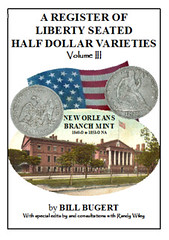 A REGISTER OF LIBERTY SEATED HALF DOLLARS, VOLUME III, NEW ORLEANS BRANCH MINT, 1840-O TO 1853-O NA
A REGISTER OF LIBERTY SEATED HALF DOLLARS, VOLUME III, NEW ORLEANS BRANCH MINT, 1840-O TO 1853-O NA
Numismatic researcher and author Bill Bugert announces the third in a series of his die marriage books on Liberty Seated half dollars. Volumes I and II released in the preceding two years detailed all the known Liberty Seated half dollar die marriages of the San Francisco and Carson City Branch Mints. This book, Volume III, continues the series with the 217 known die marriages of the early New Orleans halves.
The goals of these books are to permanently document all the die marriages, assist the beginning and advanced collectors with expanding their knowledge of the series, aid in proper variety identification, and establish a standardized nomenclature for the die marriages.
This book, as with the others, contains detailed die diagnostic information and photographs, rarity ratings, background information, edge reeding counts, design types, and much more.
Author: Bill Bugert, with special edits and consultations with Randy Wiley
Publisher: Self-published
ISBN: 978-0-9824075-2-3
Size: 531 pages
Format: 8-½" by 11" on 100# anthem gloss pager, soft cover in plastic comb binding or three holed punched (ready for your notebook)
Photos: 1,994 highly quality, most over-sized
Price: $70 postpaid via media mail to U.S. addresses (please specify format)
Availability: After July 25th from the author: Bill Bugert, 1230 Red Rock Road, Gettysburg, PA 17325-6927
KARL MOULTON TO SPEAK ON JOHN J. FORD, JR. AND THE ‘FRANKLIN HOARD'
The annual SPPN Meeting will take place at 11AM on Saturday, August 20, 2011, at the A.N.A. in Chicago, IL – at the Donald E. Stephens Convention Center, Room 4. The featured speaker will be Karl Moulton, on his upcoming book: "John J. Ford, Jr. and the ‘Franklin Hoard.'"
Karl Moulton has spent over twenty years researching John J. Ford, Jr., one of numismatics' most brilliant and controversial personalities. Thorough reading of over 200 personal letters, among other documents, allowed Moulton to compile a record of Ford's numismatic activities. In particular, Ford's association with Paul Franklin, Sr. is examined, as Moulton explores the "Franklin Hoard" controversy, in which the legitimacy of an 1853 $20 U.S. Assay Office "proof" gold coin is questioned.
JAMES E. CHARLTON AT 100
Eric Newman's not the only 100-year-old numismatist. George Cuhaj writes:
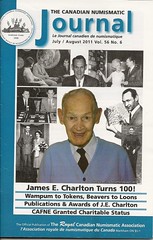 The latest issue of the Royal Canadian Numismatic Association journal (the the July/August issue) has a lead article in on James E. Charlton's 100th birthday. July 26th. Some facts:
The latest issue of the Royal Canadian Numismatic Association journal (the the July/August issue) has a lead article in on James E. Charlton's 100th birthday. July 26th. Some facts:
- Coin dealer started in 1949 as Canada Coin Exchange.
- Auctions started in 1950
- In 1952 published his first Catalog of Canadian Coins, Tokens & Fractional Currency. He directly edited 30 editions.
- Numismatic Ambassador in 2001.
Happy Birthday! The issue contains several articles devoted to Charlton, including three of special interest to numismatic bibliophiles.
- The Charlton Standard Catalogue by Alan Roy
- Charlton's Grading Guideby Alan Roy
- J.E. Charlton: Coinman to Canadians by Bret Evans
The last is about a book by H. Don Allen, a biography of James Charlton.
THE BOOK BAZARRE
M. H. BOLENDER'S COIN CHATTER
I am in the process of looking through a large number of Milferd H. Bolender sale catalogs that I acquired from David Sklow's most recent Numismatic Literature sale.
At the end on pages 44-5 in Bolender's 108th Auction Sale of Rare Coins, Medals and Paper Money, Wednesday, April 14, 1937 Bolender has two pages of what he termed, "Coin Chatter."
Bolender starts with, "Twenty Years Ago. Yes, I am the dealer, who, exactly 20 years ago this month, in a full page advertisement on the outside cover of the Philatelic West magazine, now Hobbies, offered Panama Pacific half-dollars at exactly 90 cents each! Of the several hundred in stock at the time, I sold exactly fourteen, through the ad. Collectors were slow in buying them in view of a price reduction. People buy when the prices go up! Upon my return from the army I had no difficulty in selling them at $3 each. Those were the good old days when dealers could get all the commemorative coins they needed for their trade from the commissions, and collectors weren't held up for a big profit by the dealer either. Usually they were issued at $1 and we sold them at $1.25. The old established dealers did not bring about the present state of affairs relative to commemoratives. It was unscrupulous speculators, who were not numismatists."
The third item under "Coin Chatter" was, "Cents and Sense. Where are all the small cents going to? In price, I mean? There are as many of them as every, for collectors, but the demand has so increased that few collectors are content until they are the proud owner of a bushel of them. I well remember the days when I could buy them by the hundred or oven [sic – even] thousand at 4 or 5 cents each, all uncirculated and proof condition. Included would be the scarce early dates and 1864 "L" on ribbon, now a $5 coin. All were Indian heads, of course, for that was the days before the Lincoln heads. Sometimes they sold at auction at 3 cents each." Oh for the good old days?
MORE ON THE CONSTELLATION SOUVENIR MEDAL
Pete Smith writes:
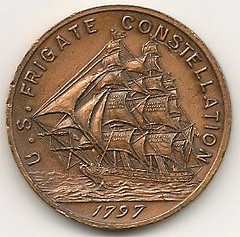 I have been in Baltimore twice for ANA conventions and several times for the Baltimore Coin and Currency Convention run by Gordon Berg and Ed Kuzmar. On my first visit I recall reading about the USS Constellation and seeing the exhibit in the Baltimore Convention Center. I was amused because I had also seen a coin exhibit that explained that the story was false.
I have been in Baltimore twice for ANA conventions and several times for the Baltimore Coin and Currency Convention run by Gordon Berg and Ed Kuzmar. On my first visit I recall reading about the USS Constellation and seeing the exhibit in the Baltimore Convention Center. I was amused because I had also seen a coin exhibit that explained that the story was false.
The original Constellation, built around 1797, was dismantled in 1853. At the same time a new ship was being constructed in the same shipyard. Apparently some pieces of the old ship were incorporated into the new ship. This may have been a form of recycling or a way to pass the heritage of the old ship on to the new. The ship now seen in Baltimore harbor first sailed in 1854.
Nails used as relics to raise funds for restoration may have been from the original ship but it was the second ship that was restored with these funds.
Some authorities in Baltimore are aware that they have an 1854 ship. Some apparently still cling to a belief, either that they have the 1797 ship, or that the 1797 ship was restored in 1854 rather than being dismantled with a new ship being built.
Dave Lange adds:
In your listing of past articles about the USS Constellation medals, you overlooked one: MAST COINS OF THE U.S.S. CONSTELLATION (www.coinbooks.org/esylum_v10n12a21.html).
To read the earlier E-Sylum article, see: THE CONSTELLATION SOUVENIR MEDAL (www.coinbooks.org/esylum_v14n27a09.html)
A CONFUSION OF SIMILAR CONSTELLATION MEDALS
This artist is often confused with Howard Chandler CHRISTY (note the Y instead of LE or IE).
Let's call Howard Chander artist of Medal No 1, and Edward L. Medal No. 2.
Medal No 1 is the U.S. Constitution Plaquette, struck in 1937 by Medallic Art Company. This artist CHRISTY was the painter of a painting that another artist, Rudolph Freund modeled after. The client was the Philadelphia jewelry firm Bailey, Banks and Biddle.
Medal No 2 is the U.S. Constellation Medal, struck in 1961 by Bastian Brothers. This artist CHRISTLE made a drawing that a factory artist in Bastian's plant rendered into a pair of round dies. The client was that Baltimore Restoration Committee mentioned in last week's E-Sylum.
The medals are often confused by the similarity of both artists' last name AND the name of the medal -- the name of the ship -- despite a handful of other factors: size, shape, composition, maker, artistic quality are the most notable.
For Medal No 2, mentioned in last week's E-Sylum and previously, it was covered extensively by Bill Swoger in his recent book, "National Commemorative Medals" ( page 215). Bill illustrates the full leaflet shown partially last week. The leaflet -- and Bill Swoger -- got the spelling correct.
Bill included this medal as an "associated item" to one struck by the Philadelphia Mint, the U.S.Constellation 175th Anniversary Medal by artists Edgar Zell Steever and Sherl Joseph Winter, struck in 1972.
I guess that makes it Medal No 3.
You can understand the confusion. Or have I confused you more?
To read the earlier E-Sylum article, see: THE CONSTELLATION SOUVENIR MEDAL (www.coinbooks.org/esylum_v14n27a09.html)
MORE ON THE LOVETT CONFEDERATE CENT
Two weeks ago, we published part of an article from The New York Times about a satirical depiction of Confederate coinage. The article stated that:
In early 1861, rebel agents commissioned a Philadelphia engraver named Robert Lovett to create for a one-cent piece.
I hate to see conjecture presented as fact. To the best of my knowledge, nobody has ever found any evidence in any records of the Confederacy that Lovett was commissioned by it to strike coins for it. In the absence of evidence to the contrary, my view is that the "Confederate Cents" have to be considered fantasy pieces. Otherwise, I LOVED the piece on the Harper's "proposal."
George Corell writes:
As an accomplished researcher on Confederate coinage issues, I cannot help but to reply to Bill Eckberg in the last issue of The E-Sylum. Conjecture presented as fact has been a big problem in the past and to this list you can add embellishment and literary license. That having been said, the simple fact of an absence of official Confederate documents linking Lovett directly to the Confederate Treasury is nothing more than a statement of what we do not know. Answers must be found and discovered outside of official documentation.
In our book: The Lovett Cent, a Confederate Story by Harold Levi and myself, we detail those discoveries by others as well as by ourselves, and evidence along with the reasoned logic and numismatic judgment necessary to analyze that data and reach our conclusions. Simple conjecture rarely carries with it anything more than a simple opinion based upon what someone does not know.
Labeling the Lovett Cent as a fantasy piece as all but a matter of fact based upon what is missing or unknown to him is the same kind of conjecture of which he admonishes. Others have unwittingly fallen into that intellectual trap before. Either Harold or I would be glad to loan him a copy of our book to read and introduce him to what is known and largely verified. Our research, reasoning, and conclusions are available to all to enlighten numismatists, not inadvertently mislead.
Bill Eckberg replies:
I purchased a copy of their book when it came out and have read it carefully and thoroughly from cover to cover. I enjoyed the book. There is a lot of interesting information in it, and I recommend it to others. However, extraordinary claims require extraordinary evidence. I stand behind what I wrote in last week's E-Sylum.
Harold Levi writes:
I agree with Bill Eckberg that technically the Confederate cent is a fantasy. At this time, there are no known Confederate records directly mentioning the Confederate cent made by Robert Lovett, Jr. This is not to say that none exist or never existed. A large volume of Confederate records were burned by officials when Richmond was evacuated in 1865 and Juda P. Benjamin (CSA Secretary of State) burned all of the records he had.
However, there are many records locked-up in private collections or as family heirlooms that have not seen the light of day since 1865. A bound volume of C.G. Memminger's (CSA Secretary of the Treasury) copy of communications was sold at auction a few years ago. The auction description indicated that it contained several letters that would be very interesting, if not enlightening, to numismatists. There are, however, many pieces of circumstantial evidence that could get you convicted in a court.
I do wonder if Adam Goodheart actually has a copy of our book or even read it. He would have been more convincing if he had gotten the name correct in his list of sources. The name is The Lovett Cent; a Confederate Story NOT The Lovett Cent: An Untold Story.
To read the earlier E-Sylum articles, see:
NOTES FROM E-SYLUM READERS: JULY 3, 2011
(www.coinbooks.org/esylum_v14n27a10.html)
HARPER'S WEEKLY "PROPOSAL" FOR A CONFEDERATE STATES COIN
(www.coinbooks.org/esylum_v14n26a17.html)
NOTES FROM E-SYLUM READERS: JULY 10, 2011
British Commemorative Medals Wins IAPN Prize
Jim Duncan of New Zealand writes:
Had you heard that Christopher Eimer's new edition of British Commemorative Medals and their Values had won the IAPN book prize? The first edition also won a medal from Krause in 1987! At least he's consistent.
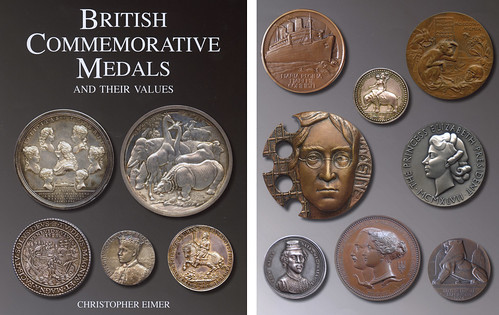
Query: Article On George VI Rupee Die Varieties Sought
Web site visitor (and new subscriber) Arash Ilavia writes:
I am looking for an article by George Falcke on the die varieties for the George VI rupee coin (India), which was published in issue no. 34 of C.O.I.N. (Compendium of International Numismatics - Published by Society for International Numismatics probably a couple of decades back). Please let me know if you can help me with just a photo copy of the article from that magazine.
Who Owns the Redbook Plate Connecticut Cent?
Regarding our discussion of the 1787 Conneticut cents illustrated in the Red Book, Byron Weston adds:
The consignor purchased it from the '86 Bowers & Merena sale. I will ask him if there is anything more he tell me about it but I would guess that the original owner would likely only be known to the auction house who sold it in 1986. Hopefully someone else might come forward with that pedigree information. I'd be just as curious as anyone to know!
Beware The Man Who Loved Books Too Much
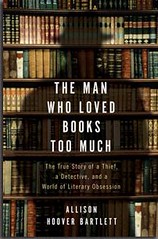
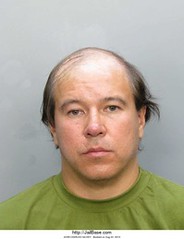
Recently we published a review of the book The Man Who Loved Books Too Much, about the notorious book thief John Gilkey. Anne Bentley writes:
I don't know if he deals in numismatics, but since he's stolen philatelic material, thought the link below to his photo might be useful for your readers.
Please be aware that convicted fraudster and thief John Gilkey is operating once again, likely out of northern California. A comic book dealer in New York state is his latest victim. Besides defrauding book dealers, Gilkey has also left his dubious mark in the print, stamp, and comics trades. He was arrested late last year in San Francisco following a parole violation, but was released after he (or someone) posted $75,000.00 bail. He then disappeared, but is active once again.
He is a serious criminal who continually looks for new opportunities and deceptions. An investigation by the SFPD is ongoing; there is an outstanding warrant for his arrest. Please do your friends the favor of re-posting this note to any and all lists of allied trades and organizations. Thank you very much.
John Waite Security Committee, ABAA
Photos of Gilkey at http://tinyurl.com/2bf5op9
To read the earlier E-Sylum article, see: BOOK REVIEW: THE MAN WHO LOVED BOOKS TOO MUCH (www.coinbooks.org/esylum_v14n24a08.html)
North Dakota Submarine Battle Coin
An E-Sylum reader writes:
Here's an interesting story about a medal with a military connection.
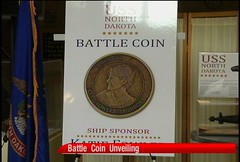 North Dakota is celebrating a milestone in the construction of USS North Dakota, the first nuclear submarine named after the state.
North Dakota is celebrating a milestone in the construction of USS North Dakota, the first nuclear submarine named after the state.
The former Secretary of the Navy, the Honorable Donald Winter, asked Katie Fowler to be the sponsor of the submarine. On Thursday, a battle coin with Fowler`s face was presented to her.
Katie Fowler has been recognized for her volunteer efforts with two Navy Public Service Awards. She`s hosted visiting foreign government officials and dignitaries.
To read the complete article, see: Battle Coin Presented to Submarine Sponsor (www.kfyrtv.com/News_Stories.asp?news=50524)
E-Books Ruined My Love Life
Kay O. Freeman writes:
This is amusing essay on another unexpected consequence of electronic reading devices.
It wasn't the first time I'd flirted my way into a Saturday night date with a simple phrase: "I love that book."
I had one good pickup line, and e-readers ruined it. I can no longer hit on a handsome man on a long commute by asking about his book — because I can't see it. Gone are the days when, sitting on a train delayed in the station, I could imagine exactly where in the New York Public Library we would first kiss — in the stacks between Mailer and Malamud or Foer and Franzen? E-books may be saving literature, but my dating life has suffered.
To read the complete article, see:
Complaint Box | How E-Readers Destroyed My Love Life
(cityroom.blogs.nytimes.com/2011/07/04/complaint-box-how
-e-readers-destroyed-my-love-life/)
THE BOOK BAZARRE
QUERY: U.S. MINT CAPT. BIDDLE MEDAL
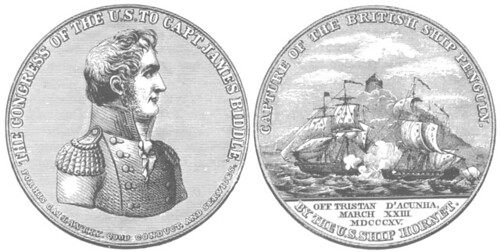
I think I saw the Congressional website while I was researching the Jarvis et. al. medal for my newsletter a month or so ago. Back in the 70s or early 80s, I purchased from the U.S. Mint a medal for Capt. Biddle for capture of the British ship Penguin off the island of Tristan da Cunha.
My question is this: When did the mint stop selling these medals or are they still available?
To read the earlier E-Sylum article, see: FEATURED WEB PAGE: CONGRESSIONAL GOLD MEDALS, 1776-2010 (www.coinbooks.org/esylum_v14n27a22.html)
ARTICLES COVER 1933 DOUBLE EAGLE LEGAL BATTLE
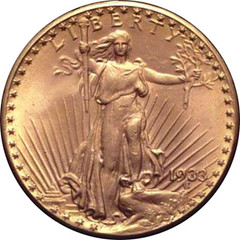 A jeweler's heirs with a cache of rare $20 gold coins will fight for the right to keep them when they square off in court this week against the U.S. Treasury.
A jeweler's heirs with a cache of rare $20 gold coins will fight for the right to keep them when they square off in court this week against the U.S. Treasury.
Treasury officials charge that the never-circulated "double eagles" were stolen from the U.S. Mint in Philadelphia in 1933. They could be worth $80 million or more, given that one sold for nearly $7.6 million in 2002.
The coins come from a batch that were struck but melted down after President Franklin D. Roosevelt took the country off the gold standard in 1933.
Two were preserved for the Smithsonian Institute. But a handful more mysteriously got out.
The daughter and grandsons of Israel Switt, a jeweler and scrap metal dealer on nearby Jeweler's Row, say they discovered 10 of them in his bank deposit box in 2003.
Joan Langbord of Philadelphia and her sons went to the U.S. Treasury to authenticate the coins, but the government instead seized them. Authorities noted that the box was rented six years after Switt died in 1990, and that the family never paid inheritance taxes on them.
What's more, the Secret Service has long believed Switt and a corrupt cashier at the Mint were somehow involved in the double-eagle breach.
"A thief cannot convey good title to stolen property," Assistant U.S. Attorney Joel M. Sweet wrote.
Switt had been investigated at least twice by 1944 over his coin holdings.
In 1937, U.S. officials seized nearly 100 pre-1933 double eagles from him as he prepared to board a train to Baltimore to meet with a coin dealer. Switt said he knew it was illegal to possess the gold coins, and said he had eventually planned to surrender them, according to a ruling issued by the trial judge this week.
In 1944, the Secret Service traced 10 separate double eagle coins that had surfaced to Switt. He acknowledged selling nine of them, but said he did not recall how he had gotten them. The statute of limitations prevented authorities from prosecuting Switt.
However, his license to deal scrap gold, which sometimes took him to the Mint, was revoked.
U.S. District Judge Legrome Davis will allow that evidence in, despite the family's efforts to block it.
"The documents appropriately go to Switt's knowledge of the repercussions from breaking the gold laws and provide evidence of a motive to conceal his possession of the ten 1933 Double Eagles presently at issue," Judge Legrome Davis wrote.
The trial is expected to last two to three weeks.
"What the Langbords are trying to say here is it's not clear what happened, that there's at least a possibility the coins were just exchanged for ounces of gold," said Armen R. Vartien, general counsel of the Professional Numismatists Guild.
"The records are incomplete, inconclusive," he said. "No one can really know what happened, and none of the people involved are alive to tell (the tale)."
To read the complete article, see: Pennsylvania Family Fights United States Treasury Over Rare 1933 Gold Coins (www.artdaily.org/index.asp?int_sec=11&int_new=48882)
Who owns 10 exceedingly rare American gold coins from 1933?
In a case that began on Thursday, jurors are getting an unusual lesson in Depression-era history, and will ultimately decide whether Mr. Switt was merely "colorful," as a lawyer for the family described him, or a thief.
Each side explained in opening arguments that, for all of the history and complexities of 1930s Mint procedures and records to come, the case is quite simple. They disagreed, however, about what the simple point of the case was.
Assistant United States Attorney Jacqueline Romero, presenting the government's case, told jurors, "You are going to hear a remarkable and intriguing story about gold coins that were stolen from the U.S. Mint."
"Israel Switt was somehow involved" in the theft, she said, probably with the help of a corrupt cashier at the Philadelphia Mint. The government had linked Mr. Switt to every double eagle that had emerged over the decades, she said, including 10 tracked down in the 1940s and one sold with the agreement of the government by a dealer, Stephen Fenton, in 2002 for $7.6 million. That sale was based on a government mistake, she said; these coins would not get the same dispensation.
The government will prove, she pledged, that the heirs knew that the goods were not legitimately theirs, and so the jury should return the coins "to their rightful owner, the people of the United States of America."
Barry Berke, a lawyer arguing on behalf of Mr. Switt's heirs, the Langbord family, told the jury that the case was, simply, about power and government overreach. Washington should not be able to seize property from citizens "unless it can prove it is entitled to — and not just powerful enough to take it," he said.
He called the government's case an attempt to "rewrite history," and promised to present alternate explanations for treasured coins coming legitimately into the Langbords' hands: the mint commonly exchanged coins for gold, he said, and the cashier of the mint kept an "open bag" of 1933 double eagles near his desk.
To read the complete article, see: Family Battles U.S. Over 10 Coins Worth Millions (www.nytimes.com/2011/07/09/us/09coin.html)
After spending three years researching the story of the 1933 Double Eagles, I'm personally of the view that the gold coins were stolen from the Mint, and that Israel Switt—the now-deceased head of the Langbord family, which claims to own the coins—either abetted the theft or agreed to fence the coins for the thieves. But I also think the U.S. government is going to have a tough time winning possession of the 1933 Double Eagles. The Langbords were smart enough to hire Barry Berke of Kramer Levin Naftalis & Frankel, who previously fought the feds to a sweet settlement in a different piece of 1933 Double Eagle litigation. (You may recall Berke as the lawyer who pulled a risky—but ultimately effective—stunt with a red handkerchief at the criminal trial of a Deutsche Bank executive accused of participating in a tax shelter scheme.)
Berke has already won a key ruling in the Philadelphia Double Eagle case that shifts the burden of proof to the government. Judge Legrome Davis concluded in 2009 that the Treasury Department had violated the Langbords' constitutional rights when it refused to return the 10 1933 Double Eagles to them after the Langbords surrendered the coins for authentication testing. Judge Davis ruled that it's now up to the feds to prove that the coins were stolen from the Mint. So as long as Berke and the Langbords can lay out a plausible scenario for how the 1933 Double Eagles could have left the Mint legally, at a time of great tumult and upheaval, they've got a shot at keeping the coins.
Those jurors in Philly should count themselves lucky to hear the case play out. (As opposed to the poor Rambus antitrust jurors, who have to be prodded to stay awake, according to this great Reuters story on the $4 billion trial underway in San Francisco state court.) OTC can't wait to see what happens next in the saga of the 1933 Double Eagles.
To read the complete article, see: This summer's best trial? The $75 ml case of the Double Eagle (newsandinsight.thomsonreuters.com/Legal/News/ViewNews.aspx?id=21581)
NUMISMATIC HEADLINE HYPE
Regarding a Time Magazine piece commenting on the case, Tom Fort writes:
Regarding this article, the last few paragraphs of advice for those collecting US coins, truer words were never spoken.
It's the kind of story, one of intrigue around the tremendous value in coins that had been sitting untouched for decades, that lures people into coins as an investment. Coin dealers like Goldine and Numis Network, which is actually a multilevel marketing outfit that deals in coins, tout the financial benefits of coin collecting.
And in a way it makes sense: What could be better than collecting money?
But here's the reality: With the exception of exceptionally rare coins in excellent condition, they have generally proven to be an unremarkable investment. And, as About.com's coin expert warns readers, the more hyped up a coin is, the worse of an investment it will tend to be. One piece of advice: Please, please, please stay away from the "modern commemorative" coins — a series of "rare" coins produced by the US Mint beginning in 1982. These are made to be collector's items and so everyone who wants them buys them and keeps them in mint condition. It's unlikely that a powerful secondary market for them will ever develop (see, for instance, collectible plates).
The story of this lawsuit will likely be used by more than a few coin dealers hocking the dream of a family fortune from rare coin investment. But most of the value in coins comes from dealing them to unsophisticated buyers, not from buying them.
To read the complete article, see: Man Fights U.S. Treasury over $80 Million in Rare Coins (moneyland.time.com/2011/07/07/man-fights-treasury-over-80-million-in-rare-coins/)
DICK JOHNSON: A PENNY FOR YOUR THOUGHTS
For over a year now Canadian newspapers have been editorializing about abolishing the cent coin. For Canada the subject is not "if" it's "when." In the United States it's not "when" its "if." With two strikes against retaining the coin for current circulation, it's a double-barrel attack for both countries. It cost more to make than its face value and its economic value as a circulating coin is not justified in advancing economic civilization.
If you are a long-time reader of The E-Sylum you will have read many of my articles that endorse abolishing both the cent and the nickel for a more streamlined coinage system for America. Drop these two denominations and add two more in multiple dollar denominations. But we are so slow to adopt innovations that have proved so successful in other countries. Australia, for example, has dropped the two lowest valued coins and is considering axing the third.
In Canada this Sunday, one writer in the North Bay Nugget (don't ask me where that is) -- only identified by name "Eweser" -- expounded on the fact he will be sad to see a lot of phrases in the English language based on the cent coin vanish along with the coin. That might not be true, but he listed the following:
A penny saved is a penny earned… I'll have to check the interest rates and get back to you on this one. This was a favorite saying of old-timers who could actually buy something with a penny…ahhh, the good old days.
Penny-wise and pound-foolish… Much like some of the government programs being implemented!
Not having two cents to rub together… I think many of us today can relate to this.
Cost a pretty penny… This one has me stumped! Does this mean that an ugly penny saves you money???
Penny ante… This means of little value or importance… much like this saying!
Cut someone off without a penny... Now why do I get the feeling that this one is really going to put a hole in my pocket?
Thanks for your indulgence, and a penny for your thoughts… (unquote)
Thanks, Eweser.
To read the complete article, see: A Penny for your Thoughts (www.nugget.ca/Community/NewsDisplay.aspx?c=167783)
THE PAPER DOLLAR VS COIN DEBATE
Peter Gaspar writes:
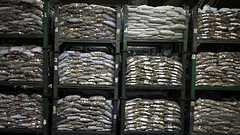 I too heard the NPR story about the huge number of dollar coins requiring storage because they do not circulate. I was disheartened by the shallowness of all the participants. Someone was quoted as saying that the dollar coin program was intended to save the government money. But the source of the saving was not mentioned - the long life of a dollar coin compared with that of a dollar banknote.
I too heard the NPR story about the huge number of dollar coins requiring storage because they do not circulate. I was disheartened by the shallowness of all the participants. Someone was quoted as saying that the dollar coin program was intended to save the government money. But the source of the saving was not mentioned - the long life of a dollar coin compared with that of a dollar banknote.
As most numismatists know, the reason that saving has not been realized is the insistence on continuing to print those dollar bills. Opposition from the BEP plate printers has contributed to this foolish policy of continuing to print dollar bills. Certainly if you ask the public they will say that they want to continue using dollar bills rather than coins. Most people resist change. I was in the UK in the early 80s when the 'round pound' was introduced. Many people protested and swore they would never switch to the pound coins. But since the Bank of England stopped the printing of one pound notes, the public had little choice but to accept the coins, and they did so rapidly. Within two years there was no mention of missing the pound note.
The same thing would happen here if the Treasury Department stopped printing dollar notes. It is obvious that this is their intention. Why else is the dollar bill the only American banknote that has not been redesigned?
I was too disgusted with the moronic nature of the NPR story, but I hope that someone with a stronger stomach does write them. They wasted an opportunity.
To read the earlier E-Sylum article, see: NATIONAL PUBLIC RADIO HIGHLIGHT'S AMERICA'S DOLLAR COIN PROBLEM (www.coinbooks.org/esylum_v14n27a11.html)
CRANE PAPER COMPANY LOOKS BEYOND U.S. FOR PROFITS
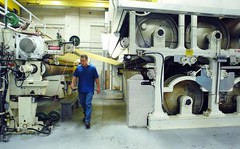 When the US government starts printing less money, what happens to the company that supplies the paper for dollar bills?
When the US government starts printing less money, what happens to the company that supplies the paper for dollar bills?
For Crane & Co. in Dalton, which produces the specialized paper for printing greenbacks, fewer bills means cuts in orders and revenue. So the company has added more governments to its customer list, including emerging economies where cash is still king and attempts to reduce counterfeiting are on the rise.
The Crane family has been making paper for US currency for more than a century - through depressions, booms, and recessions. But in 2003, the Federal Reserve System updated the technology used to screen the condition of paper currency, effectively reducing the number of bills destroyed each year. (In 1989, 46 percent of $1 bills were destroyed; in 2010, just 21 percent were.)
Over the past 20 years, the average life span of paper bills - $1s, $5s, $10s, $20s - has doubled. Longer lasting bills means the government has been printing fewer of them, according to the Fed.
That means most of Crane's business now comes from overseas.
"Selling to central banks throughout the world - that's a growing business for us for sure,'' said Charles Kittredge, the sixth-generation of his family to run Crane. "We are constantly looking for opportunities internationally.''
From its plant just outside of Stockholm, Crane produces paper for the currencies of Mexico, Thailand, India, and Egypt. For Tanzania, Sweden, and Chile, it both supplies the paper and prints the bills. It also produces enhanced security features - including specialized watermarks, fibers, and fluorescent elements - that are embedded in bills. South Korea, Costa Rica, and Lebanon buy such products from Crane.
Between 20 percent and 35 percent of the company's revenue comes from paper for US currency, down from about 50 percent in 2001, Kittredge said. He declined to reveal Crane's revenue figures.
Additional forays into paper products, such as filters to purify water and reduce air contaminants, are replacing the company's once-strong position in stationery, Kittredge said. The company also makes security papers for US and Swedish passports.
Kittredge maintained that Crane will remain a company rooted in US currency. "The fun thing for me is to stand up in front of an audience anywhere in the country and be able to say that Crane & Co. products are in 98 percent of their pockets,'' he said. "We're ubiquitous.''
To read the complete article, see: Still making money (www.boston.com/business/articles/2011/07/09/the_money_maker_goes_global/)
BEP'S PRODUCTION OF PAPER MONEY HAS SLOWED
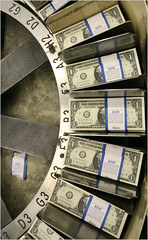 The number of dollar bills rolling off the great government presses here and in Fort Worth fell to a modern low in the last fiscal year. Production of $5 bills also dropped to the lowest level in 30 years. And for the first time in that period, the Treasury Department did not print any $10 bills.
The number of dollar bills rolling off the great government presses here and in Fort Worth fell to a modern low in the last fiscal year. Production of $5 bills also dropped to the lowest level in 30 years. And for the first time in that period, the Treasury Department did not print any $10 bills.
The meaning seems clear. The future is here. Cash is in decline.
You can't use it for online purchases, nor on many airplanes to buy snacks or duty-free goods. Last year, 36 percent of taxi fares in New York were paid with plastic. At Commerce, a restaurant in the West Village in Manhattan, the bar menus read, "Credit cards only. No cash please. Thank you."
There is no definitive data on all of this. Cash transactions are notoriously hard to track, in part because people use cash when they do not want to be tracked. But a simple ratio is illuminating. In 1970, at the dawn of plastic payment, the value of United States currency in domestic circulation equaled about 5 percent of the nation's economic activity. Last year, the value of currency in domestic circulation equaled about 2.5 percent of economic activity.
"This morning I bought a gallon of milk for $2.50 at a Mobil station, and I paid with my credit card," said Tony Zazula, co-owner of Commerce restaurant, who spoke with a reporter while traveling in upstate New York. "I do carry a little cash, but only for gratuities."
It is easy to look down the slope of this trend and predict the end of paper currency. Easy, but probably wrong. Most Americans prefer to use cash at least some of the time, and even those who do not, like Mr. Zazula, grudgingly concede they cannot live without it.
Indeed, cash remains so pervasive, and the pace of change so slow, that Ron Shevlin, an analyst with the Boston research firm Aite Group, recently calculated that Americans would still be using paper currency in 200 years.
"Cash works for us," Mr. Shevlin said. "The downward trend is clear, but change advocates always overestimate how quickly these things will happen."
Production of paper currency is declining much more quickly than actual currency use because the bills are lasting longer. Thanks to technological advances, the average dollar bill now circulates for 40 months, up from 18 months two decades ago, according to Federal Reserve estimates.
To read the complete article, see: As Plastic Reigns, the Treasury Slows Its Printing Presses (www.nytimes.com/2011/07/07/business/07currency.html)
HOW MONEY IS MADE AT THE U.S. BUREAU OF ENGRAVING AND PRINTING
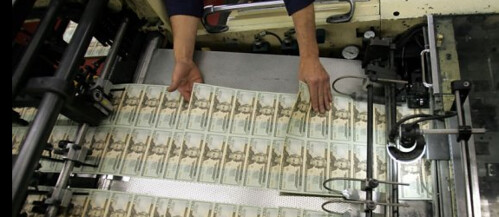
Get this: Last year, the U.S. Treasury Department printed no $10 bills. Zero.
When was the last time you used a Hamilton? Or, really, when was the last time you used cash?
Paper money is in decline, The New York Times reports. Today, the preferred way to pay is plastic.
You can't use cash on Amazon.com. You can't mail Apple an envelope full of money when you download from iTunes. Heck, you can't even use Washingtons or Lincolns anymore to buy snacks on most airlines.
And there's one big exception to this trend – $100 bills are in high demand. Last year was the first time the Treasury printed more C-notes than singles, the NYT reports. And in places with fickle economies, U.S. $100 bills are hoarded almost like they're gold.
It's all about the Benjamins, baby.

To read the complete article, see:
How cash money is made
(blog.seattlepi.com/thebigblog/2011/07/07/who-uses-cash
-anymore-fewer-and-fewer-americans-do/)
TEN DOLLARS FOR A FIRESIDE CHAT WITH DAVE BOWERS!
THE EYE OF GOD IN NUMISMATICS
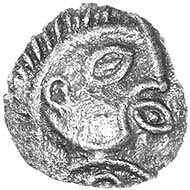
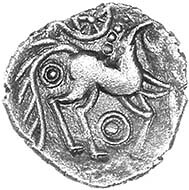
A rare silver coin of the Iceni, struck in Norfolk over 2000 years ago, was recently found by a metal detectorist in East Anglia. It shows a man's head with one eye blinded (or closed) and with another eye – a third eye, an open eye – in his mouth. Who is he? What is he doing?
I think he may be an Icenian counterpart of the Norse god Odin (German Woden, Anglo-Saxon Wotan) who sacrificed one eye in order to gain wisdom and the gift of prophecy. I think this amazing coin depicts the deity looking inwardly into the future – not with his physical eyes, but with his ‘inner eye' or ‘third eye' – and foretelling the future like a shaman or seer; in other words, he seems to be speaking with the all-seeing, all-knowing ‘eye of God'.
This is why I believe Odin (or whatever his Icenian name was) is portrayed here with an eye in his mouth – he is speaking with insight – and this is why I call the coin ‘Odin's Eye'.
You may well wonder how a Scandinavian/Germanic god came to be on an ancient British coin, especially when that coin was minted hundreds of years before the Anglo-Saxons and Vikings invaded Britain.
Dr Daphne Nash Briggs, author of Coinage in the Celtic World (Seaby 1987, Spink 2004) thinks that an ancient Germanic ancestry may have influenced the language, iconography and coin inscriptions of the Iceni and cites their famous Norfolk Wolf gold staters as evidence of this (Chris Rudd List 100, July 2008, pp. 8-9, Chris Rudd List 110, March 2010, pp. 2-4).
Moreover, a number of iron age coins of northern and north-eastern Gaul – those parts of Gaul most obviously influenced by Germanic culture – give prominent display to the ‘eye of God'. One of them, a cast potin coin of the Suessiones, is nothing short of fantastic.
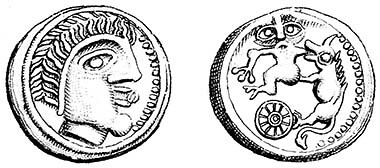
On one side we see a man with an eye in his mouth, like the Odin's Eye coin but treated more realistically; on the other side we see Tyr (a son of Odin) with his left hand in the jaws of the wolf Fenrir who is standing on a sun-wheel. A superb specimen of this mythologically fascinating coin – as remarkable as it is rare – was recently sold for 2400 euros.
To read the complete article, see: The eye of God (www.coinsweekly.com/en/News/4?&id=676)
MORE ON THE MULTI-$BILLION TREASURE DISCOVERED IN INDIA
A court-ordered search of vaults beneath a south Indian temple has unearthed gold, jewels and statues worth an estimated $22 billion, government officials said Monday.
The treasure trove, at the 16th century Sri Padmanabhaswamy temple, is widely believed to be the largest find of its kind in India, catching officials in the state of Kerala by surprise and forcing the government to send two dozen police officers to the previously unguarded shrine for round-the-clock security.
The discovery has also revived questions about who should manage the wealth, much of which is believed to have been deposited at the temple by the royal family of the princely state of Travancore, which acceded to India when the country became independent in 1947. Some of the vaults under the temple have not been opened for nearly 150 years, temple officials have said.
Temples in India often have rich endowments, mainly from donations of gold and cash by pilgrims and wealthy patrons, but the wealth discovered at Padmanabhaswamy dwarfs the known assets of every other Indian temple.
To read the complete article, see: Beneath a Temple in Southern India, a Treasure Trove of Staggering Riches (www.nytimes.com/2011/07/05/world/asia/05india.html)
 What should India, rising but still plagued by poverty, do with a newly discovered treasure of gold coins, statues and jewels in the vault of a Hindu temple, valued at some $22 billion?
What should India, rising but still plagued by poverty, do with a newly discovered treasure of gold coins, statues and jewels in the vault of a Hindu temple, valued at some $22 billion?
Suggestions are pouring in from across the country and the world. Some say it should be used to establish universities and colleges. The man who brought the court case that resulted in the unveiling wants it handed over to the Kerala state government. Others want a subway system.
But here in Thiruvananthapuram, the capital of Kerala formerly known as Trivandrum, many people — including the state's top elected official, Hindus and the royal family that once ruled this part of India and still oversees the temple — argue that the treasure should remain, largely untouched, at the Sri Padmanabhaswamy temple where it has been housed for centuries.
Their attitude partly reflects a suspicion that public officials entrusted with large sums of money will pocket much of it and mismanage the rest.
To read the complete article, see: A $22 Billion Question for India: What to Do With a Treasure? (www.nytimes.com/2011/07/09/world/asia/09temple.html)
With five vaults uncovered, a team named by the country's Supreme Court to monitor the treasure hunt said the valuables could be worth up to a trillion rupees or $22 billion.
"The size of it is staggering," Chowdhury said. "But the archeological significance perhaps outweighs the monetary value of it."
A sixth vault was to be explored Monday while a seventh vault — reinforced with iron walls — will be opened only under direction from India's top court, Agence France-Presse reported.
Chowdhury said the seventh chamber is likely the oldest in the temple and could contain dazzling artifacts dating back to the 16th century when the temple was constructed.
India's national conservation agency, the Archaeological Survey of India (ASI), said it was stunned by the findings.
"Right now we are working in absolute darkness and we only know that fabulous treasure is pouring out," ASI Director-General Gautam Sengupta told AFP.
To read the complete article, see:
India's $22B treasure trove has great 'archeological significance': expert
(www.edmontonjournal.com/technology/India+treasure+trove+
great+archeological+significance+expert/5047937/story.html)
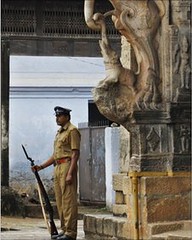 Officials in the Indian state of Kerala are drawing up a security plan for a temple where vast amounts of treasure are reported to have been found.
Officials in the Indian state of Kerala are drawing up a security plan for a temple where vast amounts of treasure are reported to have been found.
The Supreme Court wants to know how the riches will be kept safe before a sixth vault is opened, possibly next week.
Five temple vaults have been inventoried but the sixth and last chamber - which has an iron wall and was last opened 136 years ago - is said to contain much more.
"The temple and its treasures are important for us and it's our duty to provide adequate security for them," Kerala Finance Minister KM Mani said.
To read the complete article, see: India: Security plan ordered for treasure temple (www.bbc.co.uk/news/world-south-asia-14082651)
GOLD COIN HOARD FOUND IN FRENCH CELLAR
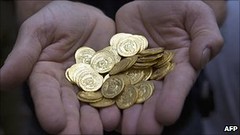 A French couple have found a hoard of gold coins worth at least 100,000 euros (£89,000; $140,000) in the cellar of their home in the town of Millau.
A French couple have found a hoard of gold coins worth at least 100,000 euros (£89,000; $140,000) in the cellar of their home in the town of Millau.
They were working on their drains when they dug up the 34 coins in a little clay pot, French media said.
The coins date from 1595 to the French Revolution, which began in 1789, said a local coin expert who evaluated them.
The most valuable is a double louis from 1640, during the reign of Louis XIII, worth 6,500 euros.
Under French law, the couple are allowed to keep the treasure because it was found on their own property, Mr Aigouy said.
To read the complete article, see: Gold hoard found in French cellar (www.bbc.co.uk/news/world-europe-14080228)
AUSTRALIAN HOLEY DOLLAR SELLS FOR RECORD PRICE
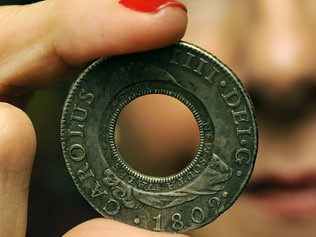
ALREADY passed through innumerable sets of hands, one of Australia's first coins has been sold to a new owner for close to half a million dollars.
A Melbourne-based collector bought one of the 300 remaining holey dollars for $485,000, a record price for this type of coin. The purchase comes almost 200 years after the British government bought 40,000 Spanish silver dollars to solve a currency shortage in its fledgling penal colony, trading on crudely drawn bills and rum.
A hole was then punched through the centre to devalue and localise the coins to ensure they weren't smuggled out of Australia. Belinda Downie, managing director of rare currency dealer, Coinworks, who sold the holey dollar last month, said the coin had probably travelled the world before arriving in Australia around 1813.
It was originally minted in Spain in 1789, an era in which the silver dollar was regarded as the key international currency.
Most holey dollars were returned to Britain to be melted down and sold as silver bullion as they were phased out of circulation.
To read the complete article, see:
Historic Australian holey dollar sells for record $485,000
(www.news.com.au/national/historic-australian-holey-dollar-
sells-for-record-485000/story-e6frfkvr-1226087396886)
FEATURED WEB PAGE: BRITISH SERVICE MEDALS OF THE FIRST WORLD WAR
This week's Featured Web Page is on British Service Medals of the First World War, from the Imperial War Museum web site.British and Commonwealth servicemen and servicewomen were awarded a wide variety of orders, medals and decorations for their service in the First World War. These included medals for gallantry, distinguished service and those bestowed by Allied governments. General service during the First World War was recognised by the issue of the 1914 Star (or the 1914-15 Star), the British War Medal 1914-1920 and the Victory Medal 1914-1919. These medals were issued in unprecedented numbers. Virtually all service personnel, and those civilians who served in an officially recognised organisation qualified for one of more of these medals.
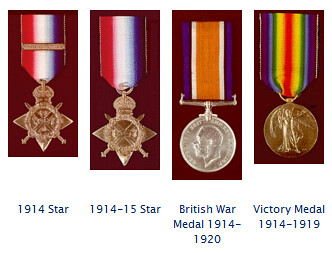
www.iwm.org.uk/server/show/ConWebDoc.986


